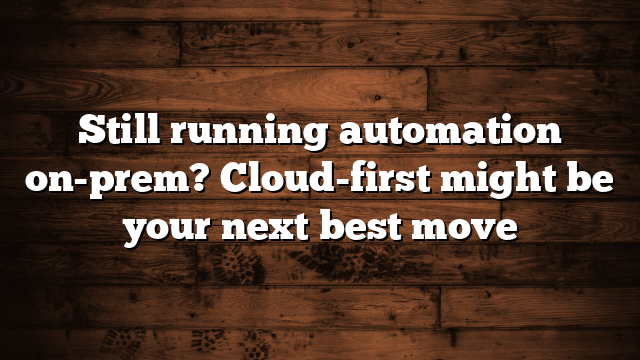Not long ago, automation lived on-prem. Jobs were tightly coupled to physical servers, automation was often treated as a back-office utility and schedulers were sized to match static infrastructure. But IT environments don’t stand still anymore — and automation can’t either.
As teams shift toward hybrid and cloud technologies, workload automation (WLA) needs to evolve, too. Not because your current solution is broken, but because cloud-first tools are better equipped to support growth, change and resilience. The right strategy allows you to extend what you have on-premises while taking advantage of cloud-based solutions where they make sense.
Cloud-first doesn’t mean cloud-only
Some processes still belong on-prem, and many organizations will remain hybrid or multi-cloud for the long haul. That’s normal. Automation has to meet your business where it is, not force a complete replatforming.
Cloud-first means choosing SaaS-native automation tools when expanding capabilities or modernizing parts of your environment. It gives your teams the flexibility to automate across ERP, data platforms, DevOps and more, so you can integrate quickly and reduce manual maintenance.
The goal isn’t to rip and replace. It’s to simplify what’s complex and make your WLA platform future-ready.
Why workload automation works better in the cloud
Legacy systems were built for a different era. They do the job, but they require tuning, patching and on-prem support that doesn’t scale easily. As automation becomes more central to digital operations, these limits start to matter.
Cloud-first WLA removes the infrastructure burden and adapts to shifting demand without manual overhead.
| Benefit | Value provided |
|---|---|
| Built-in elasticity 🤸 | Adds dynamic, on-demand scaling to manage variable workloads automatically, reducing the need for manual resource forecasting and provisioning |
| Faster time-to-value 🚀 | Provides immediate access to the latest features and innovations through continuous, automatic updates, eliminating planned upgrade cycles |
| Centralized control across hybrid systems 🎯 | Extends your existing central control to seamlessly manage and monitor workflows across both on-premises and cloud-native environments from a single interface |
| Always-on reliability 🔒 | Ensures business continuity with built-in, automated failover and disaster recovery, freeing your team to focus on strategic initiatives |
| Pay-as-you-grow economics 💸 | Optimizes resource spending by providing a flexible, value-based model that eliminates the need for risky upfront capital investment |
| Easier integration 🔗 | Accelerates the adoption of new technologies through a continuously expanding library of pre-built connectors, reducing development time and custom scripting |
| Support for modern use cases 💡 | Unlocks new automation possibilities, such as event-driven workflows and real-time data pipelines, resulting in improved adaptability and streamlined business outcomes |
Automation goals haven’t changed — the delivery model has
The reason to automate hasn’t changed: reduce errors, speed up processes and free up people for higher-value work. What’s changed is how quickly your automation platform needs to adapt to business needs.
A cloud-first approach helps you respond to business demands without waiting on infrastructure. New processes can be built and deployed faster. New systems can be connected in less time. And your teams can focus on building value, not maintaining tools.
You don’t lose control. You gain capacity.
It also reduces technical debt. Instead of holding on to legacy schedulers that require custom scripts and tribal knowledge, you get a system that evolves with you. One that enables better governance, compliance and transparency across IT and business operations.
Respecting the value of existing systems
If you’re already using a WLA solution on-prem, you’ve laid a strong foundation. You know the value of automation, the importance of visibility and the impact of reliable scheduling.
But if you’re finding it harder to scale, integrate or support new initiatives, it may be time to extend your automation with a cloud-first option. That means giving your team a platform that’s built for what’s next.
Many teams continue to use their on-prem automation alongside cloud-first orchestration. It’s not all or nothing. The benefit is having the freedom to move at your own pace, modernizing high-impact workflows first and expanding as needed.
RunMyJobs by Redwood: Cloud-native automation that grows with you
RunMyJobs is Redwood Software’s SaaS-native WLA platform. It’s built for hybrid and cloud environments from the start and used by enterprises worldwide to orchestrate complex workflows across SAP, DevOps, data platforms, finance and more.
What makes it different:
- True cloud-native: No agents, no patching, no servers to manage
- Built-in support for SAP: S/4HANA, RISE with SAP, IDoc monitoring and more
- Integration-ready: Prebuilt connectors for cloud services, ERP, file transfer, containers and CI/CD pipelines
- Always-on performance: High availability with global redundancy and 24/7 support
- Transparent pricing: Usage-based licensing with no agent or job count restrictions
RunMyJobs is ideal for teams that want to reduce manual scheduling, eliminate job failures and improve SLA performance. It brings together business-critical workloads in one view, so you can monitor, control and scale without complexity.
Many Redwood customers use RunMyJobs alongside their existing automation tools. It allows them to modernize at their own pace, starting with the processes that benefit most from agility, visibility and scale.
Thinking about your next move?
If automation is a critical part of your business, your platform shouldn’t be a limiting factor. Cloud-first WLA gives you a way to move faster without taking on more infrastructure, risk or overhead. Use it to extend your automation strategy — not upend it.
Read more about Redwood’s unique approach to WLA migration and how our teams prepare you for a smooth transition from legacy to cloud.

